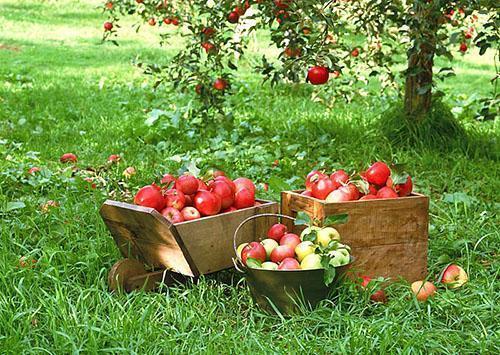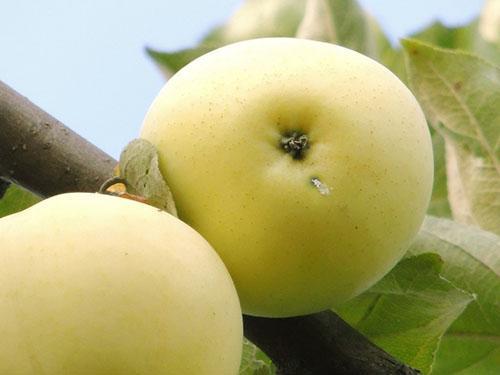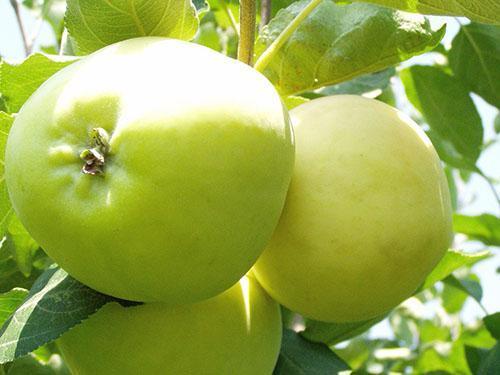Choosing early varieties of apples from a photo with a description
 The apple is traditionally considered one of the most beloved and revered fruits in Russia. And since in most regions summer does not please with its duration and warmth, the fruits of summer varieties become a real decoration of the table, a source of vitamins and a joy for children and adults.
The apple is traditionally considered one of the most beloved and revered fruits in Russia. And since in most regions summer does not please with its duration and warmth, the fruits of summer varieties become a real decoration of the table, a source of vitamins and a joy for children and adults.
Today, breeders have created many interesting summer varieties of apple trees that give bountiful harvests in regions previously considered unsuitable for growing this crop. Not forgotten are the old early varieties, obtained not in the conditions of experimental stations and institutes, but by the method of "folk selection", and tested by many generations of gardeners.
As a rule, the first summer apples are rich in sugars, quite juicy and have excellent taste. The only drawback of such fruits is that they cannot be stored for a long time, therefore they are used fresh, go for juices and fruit preservation.
Descriptions and photos of early varieties of apple trees will be a good help when choosing a plant for planting in a personal plot or laying a new garden.
Description and photo of the apple tree White filling

From the beginning of the 20th century to the present day, botanists have been arguing about the sign of equality between the variety and White filling and Papirovka. If in 1937 in the reference manual for agronomists the varieties were mentioned separately, then the descriptions of fruit trees published in 2005 united these varieties of folk selection. Indeed, the description of the White filling apple practically duplicates the information about Papirovka, which in a little over a hundred years has become one of the most common early varieties in Russia. And today the old variety is zoned in all regions of the country, except for the Far East, the Urals and Eastern Siberia. In addition, on the basis of Papirovka or White filling, scientists have created about 20 new promising varieties.
Apple-tree varieties White filling is a tree of medium height with an almost pyramidal crown, which becomes wider in adult plants over the years. The main part of the ovary is formed on annelids, while the shoots are covered with medium-sized ovoid foliage. On the back, the leaves are heavily pubescent, have small, well-defined septa and serrated edges.
Apple tree Papirovka
 Papirovka begins to bear fruit rather quickly, the first ovary appears on trees 4–5 years after planting. The variety tolerates frost well, but traces of scab can often be seen on the leaves of the apple tree and on the fruits.
Papirovka begins to bear fruit rather quickly, the first ovary appears on trees 4–5 years after planting. The variety tolerates frost well, but traces of scab can often be seen on the leaves of the apple tree and on the fruits.
Apple trees bloom in May, and the fruits of the Papirovka apple tree, which are well known to gardeners from different parts of the country according to the description and photos, ripen in the first decade of August.
Medium-sized apples have a conical shape and are clearly visible on the light yellow, blush-free skin of the ribs. Most fruits have a kind of skin ridge or seam. When the fruit is ready to be removed from the branches, the thin dry skin turns almost white, which is why the variety got one of its names. Apples have the same white and coarse-grained flesh with a refreshing taste with well-discernible acidity.
Like many summer varieties of apple trees, the fruits of the White filling are good immediately after removal from the branches, since dark spots soon appear on the skin from the slightest pressure, and the flesh becomes loose, dry and mealy. Papirovka apples cannot be transported and can be stored for a maximum of two weeks.
Apple variety Candy
 As a result of cross-pollination of the old "folk" varieties White filling and Korobovka at the V. Michurin, the variety of the Candy apple tree was obtained, which is distinguished by rapidly growing trees, unpretentiousness and good, in the conditions of Russian regions, winter hardiness.
As a result of cross-pollination of the old "folk" varieties White filling and Korobovka at the V. Michurin, the variety of the Candy apple tree was obtained, which is distinguished by rapidly growing trees, unpretentiousness and good, in the conditions of Russian regions, winter hardiness.
On average, a tree of the Candy tree variety begins to form an ovary already 4–5 years after planting, forming a powerful, spreading crown. Apple tree shoots are densely covered with leathery leaves of rich green color. At the same time, the tree responds perfectly to pruning, not only increasing the number of ripening fruits, but also allowing gardeners of the northern regions to grow the crop as a bush or creeping plant. And although horticultural farms do not use Candy apple trees due to the complexity of crown formation, amateur gardeners have long appreciated the advantages of this culture.
The frost resistance of the variety allows planting apple trees even in the Siberian region, and in central Russia, the northern cultivation border runs along the north of the Moscow region. Even young trees of the Konfetnoye variety can produce from 30 to 50 kg of juicy fragrant fruits that ripen in mid-August, do not crumble until they are harvested and are stored for up to two months.
According to the photo and description of the Candy apple variety, the tree gives even, very sweet apples of commercial quality, weighing from 80 to 120 grams. The cover color of the fruit is yellow, and a bright pattern of large red stripes forms on top of it by August.
Photo and description of the Golden Chinese apple tree
 Small apples of early Golden Chinese that ripen at the end of July attract both with their unusual appearance and sweet and sour taste. The variety appeared at the turn of the 19th and 20th centuries, thanks to the efforts of I.V. Michurin from crossing White filling and Kitayka. Today the variety is zoned in the Volgo-Vyatka and Northwestern regions of Russia, but is grown in a much larger number of regions.
Small apples of early Golden Chinese that ripen at the end of July attract both with their unusual appearance and sweet and sour taste. The variety appeared at the turn of the 19th and 20th centuries, thanks to the efforts of I.V. Michurin from crossing White filling and Kitayka. Today the variety is zoned in the Volgo-Vyatka and Northwestern regions of Russia, but is grown in a much larger number of regions.
The trees are medium-sized, up to a certain point with a vertical crown in the form of an inverted pyramid. As it grows, the apple tree becomes spreading, and under the load of fruits, long branches with sparse leaves are able to bend to the ground. The leaves of this variety are elongated, light green, mostly located at the tops of the shoots.
The fruits of the golden Chinese apple tree, as in the photo, are attached to flexible stalks, weigh from 20 to 40 grams and stand out with a beautiful amber-yellow color without any traces of blush. The pulp of sour-sweet apples has a light aroma and is quite juicy.
Like some other summer varieties of apple trees, the fruits of the Golden Chinese are poured as they ripen, becoming almost transparent. If you miss the moment of ripening, the apples quickly fall off, and after a week they practically lose their juiciness.
The beginning of fruiting of an early apple variety falls on 3-5 years, while the apple tree tolerates frost well, but is often affected by scab. The variety is characterized by the frequency of fruiting and requires apple pollinators, for example, White filling or, according to the description, the Grushovka Moskovskaya apple tree nearby.
Apple variety Melba
 The famous summer ripening variety in 1898 was created by breeders in Canada from the free pollination of the Macintosh variety. Already at the beginning of the last century, Melba became known in Russia, where it gained significant popularity.
The famous summer ripening variety in 1898 was created by breeders in Canada from the free pollination of the Macintosh variety. Already at the beginning of the last century, Melba became known in Russia, where it gained significant popularity.
Until now, the Melba apple variety has been zoned and grown almost throughout the country, except for the most unfavorable regions of the Urals, the Far East and North-East Siberia.
Fruiting from the age of 3-5 years of apple trees Melba are tall, spreading with a rounded crown of medium density.Young saplings have a pyramidal structure. The fruits are tied on ringlets, the branches are covered with oval light green or yellowish leaves, which are noticeably larger on young, powerful shoots. In May, there is a massive appearance of large pink-purple buds and white flowers. The variety is distinguished by high yields of early dessert apples.
The fruits of the Melba apple tree weigh 120–140 grams, and in some cases it is possible to obtain 200-gram, rounded or rounded-conical apples. Ripe fruits have a smooth, oily or waxy bloom of light yellowish or greenish color with a pink or carmine blush spread over most of the surface, on which red stripes are noticeable.
Compared to other summer varieties of apple trees, the aromatic fruits of Melba can be transported, and slightly unripe apples, if stored carefully, retain their properties until January. Delicate juicy apple pulp does not change its properties and does not lose its sweet, candy-like aroma. Among the main disadvantages, according to the available photos and descriptions of an early apple variety, there is a weak resistance to scab, cyclic fruiting, inherent in mature trees and insufficient winter hardiness. Under normal conditions, Melba apples ripen in August, but in cold, cloudy weather, the harvest time is delayed until mid-September.
With the participation of the Melba apple tree, over 20 new varieties have been created. Among them are the Early Aloe apple variety, as well as Red Aloe and Caravel, which are more resistant to diseases and large brightly colored fruits.
Apple-tree varieties Early aloe
 The first fruiting of the Early Aloe apple tree obtained from the crossing of Melba and Papirovka was recorded in 1973, and 15 years later the variety was included in the State Register. The apple tree took a lot from its "parents", but differs in the best scab resistance and frost resistance. In addition, the fruiting of small trees with an almost round crown begins two weeks earlier than Melba. The branches of this summer variety are covered with medium-sized oval leaves with a light, shiny outer surface.
The first fruiting of the Early Aloe apple tree obtained from the crossing of Melba and Papirovka was recorded in 1973, and 15 years later the variety was included in the State Register. The apple tree took a lot from its "parents", but differs in the best scab resistance and frost resistance. In addition, the fruiting of small trees with an almost round crown begins two weeks earlier than Melba. The branches of this summer variety are covered with medium-sized oval leaves with a light, shiny outer surface.
Apple trees give stable high yields of round or cone-shaped apples, covered with a thin glossy skin, half of which is occupied by a bright dark red striped blush, intensifying towards the stalk. The apple pulp is juicy, white or creamy with hardly noticeable graininess.
Apple-tree Grushovka Moscow: description and photo
 Moscow pear is a long-known and favorite variety of "folk" selection, characterized by early and abundant fruit formation. As indicated in the description, the Grushovka Moskovskaya apple tree can be grown in many regions of Russia, including almost the entire European territory, the Urals, West and East of Siberia.
Moscow pear is a long-known and favorite variety of "folk" selection, characterized by early and abundant fruit formation. As indicated in the description, the Grushovka Moskovskaya apple tree can be grown in many regions of Russia, including almost the entire European territory, the Urals, West and East of Siberia.
Today apple trees that can withstand even 50-degree frosts are one of the most cold-resistant varieties. Large trees with a well-developed round or spreading crown begin to bear fruit 5–6 years after planting in the ground. Flowering begins, like most summer apple trees, in May. The petals collected in buds are pink in color, and whiten as the flowers open. In summer, the branches have a dense foliage, consisting of oval or elongated green or yellow-green leaves with a finely toothed edge.
The fruits of the Grushovka Moskovskaya apple tree ripen in July and August, the average weight of round or flattened flat apples does not exceed 120 grams. At the same time, from 80 to 170 kg are collected from one tree.
However, fruiting cannot be called massive, since the ripening of apples inside the crown and at the top, in comparison with the lower branches, is significantly delayed. The peel of the fruits of the Grushovka Moskovskaya apple tree, according to the description, is covered with a waxy layer, rather thin and smooth. The cover color of a ripe apple is almost white or with a barely noticeable yellow tinge.Up to 80% of the fruit surface is occupied by a dark pink or carmine blush with blurred or even stripes. Juicy after picking, creamy or pinkish pulp of aromatic apples quickly becomes mealy. Apples are not stored, and in rainy weather they can be affected by scab.